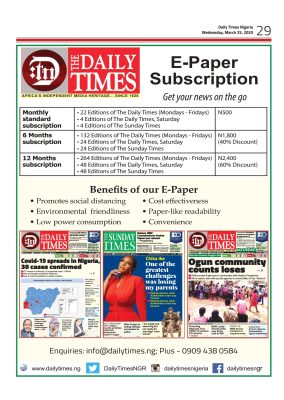Ogun, Zamfara, Edo lead with no record of medical equipment purchase in 2023

BY UKPONO UKPONG
Despite pressing healthcare needs across the nation, nine states including Edo, Katsina, Ogun, and Zamfara, made no expenditure on medical equipment in their 2023 budget year.
This was revealed in the BudgIT’s 2024 State of States Report, launched yesterday in Abuja.
BudgIT, a prime civic-tech organisation leading the advocacy for fiscal transparency and accountability in Nigeria, has launched the 2024 edition of its annual State of States Report, themed ‘Moving Healthcare Delivery from Suboptimal to Optimal.’
The report identified Edo, Ekiti, Katsina, Ogun, Ondo, Osun, Oyo, Yobe, and Zamfara as the states with no record of medical equipment purchases, raising concerns over their ability to deliver essential health services to residents.
“Regarding health, cumulatively, all 36 states allocated N2.3tn to the health sector but spent N1.39tn, representing a 58.16% budget performance. On the purchase of medical equipment, an aggregate of N35.72bn was spent; however, nine states had no record of expenses for this purchase in their 2023 budget implementation reports. Those states include Edo, Ekiti, Katsina, Ogun, Ondo, Osun, Oyo, Yobe and Zamfara.”
Furthermore, N104.27bn was spent on constructing and rehabilitating hospitals and clinics across the subnationals. On the purchase of drugs and medical supplies, a combined amount of N15.31bn was spent, excluding Delta, Ebonyi and Niger States, which held no records. Investments in healthcare are still very far from the ideal and need to be prioritised.
A vital aspect needing attention is the subnational physical health infrastructure. The National Health Facility Registry records an aggregate of 38,182 hospitals across the 36 states of the country, of which 25.92% are privately owned and 74.08% are government-owned, with 27,022 facilities being primary health centres and 1188 being secondary and tertiary.
The public primary health facilities serve an estimated ratio of 8,960 people to one facility. Although not above the WHO recommendation of 10,000 people to a basic facility, it is, however, essential to note that this ratio puts significant pressure on the existing facilities and infrastructure, highlighting the need for more supply across the country, especially as the PHCs are not evenly distributed across states.
READ ALSO: Appreciating Adedeji’s Efforts On…
Nigeria is undoubtedly facing the challenge of inadequate health professionals, with a doctor-to-patient ratio of four doctors to 10,000 patients, which is against the WHO recommendation of 1:600 patients. There is a severe shortage of professionals across the country. While Taraba boasts of just 201 doctors, leaving the state at a doctor-to-patient ratio of 1:17,959, only 10.9% of hospitals and clinics in Bauchi can boast of having at least one general medical doctor.
In addition to inadequate infrastructure, limited availability of drugs and medical supplies, and shortage of medical professionals, the states struggle with adequate capacity to address chronic and infectious diseases. Malaria is one major contender, having severely dealt with states like Kogi, Plateau, Niger, Ondo, Borno, Ebonyi and Plateau mainly during the rainy seasons, with Borno State alone reporting 527,305 cases in 2023, 15,036 of which majority were severe.
Other diseases bedevilling the states include cholera, tuberculosis (32,297 cases reported in Kaduna in 2023), and measles, which occur more in northern states. Infectious diseases such as CSM seem to have a foothold in Yobe State, while Lassa fever is present in Kogi and Anambra.







